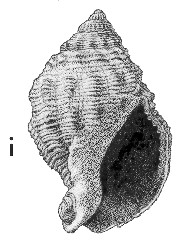
Revised descriptions of New Zealand Cenozoic Mollusca from Beu and Maxwell (1990)

 | Revised descriptions of New Zealand Cenozoic Mollusca from Beu and Maxwell (1990) | 
|
  (Pl. 21i): GS165, J39/f6470, White Rock River, South Canterbury, Altonian (GNS) |
Beu & Maxwell (1990): Chapter 11; p. 200; pl. 21 i.
Synonymy: Cominella subnodosa Hutton 1877b, p. 596; Siphonalia subnodosa; Austrofusus (Zelandiella) subnodosa; Zelandiella subnodosa, Beu & Maxwell 1990, p. 200, pl. 21i.
Type species of Zelandiella Finlay, 1926
Classification: Buccinulidae
Description: Size moderate for subfamily (height 30-40 mm), cominelliform, spire conical, low, 0.35-0.4 total height. Protoconch mamillate, of about 3.5 convex whorls, last 0.4 whorl with opisthocyrt costellae, remainder smooth. Teleoconch of about 6 whorls, early whorls convex, later whorls angled just above suture, sutural ramp concave with a prominent subsutural fold, strongly clasping previous whorl. Last whorl with second angulation on base, convex below to short, thick, twisted neck. Axial sculpture commencing as rounded costae reaching virtually from suture to suture, but on later whorls restricted to rounded nodules on shoulder angle and subsutural fold, and on last whorl on basal angulation as well; 11-13 nodules on penultimate whorl. Spiral sculpture of narrow, low cords, typically subequal, but a few basal cords noticeably stronger than others in some shells. Aperture large, columella almost straight above, twisted to left below; siphonal canal short, twisted, strongly notched; fasciole prominent, squarish, upper edge margined by a sharp ridge, lower edge also bounded by a ridge, but in many specimens obscured by inner lip callus. Inner lip callus well developed, spreading laterally over columella and base, typically closely attached to shell but outer edge detached or even deflected in a few shells. Outer lip thin, in well preserved shells finely lirate within and having a shallow indentation near anterior end.
Comparison: Two species of Aethocola (Zelandiella) are recorded from the Double Corner Shellbeds, Lower Waipara Gorge (Waiauan) — one is the highly distinctive A. fatua (Pl. 30c, e), the other is very similar to A. subnodosa but differs in being lower-spired, and in having more subdued teleoconch sculpture. The supposed species differences are not constant, however, and may not be taxonomically significant. A. calcarata (Lillburnian-Tongaporutuan, widespread) is very similar to A. subnodosa in shape and sculpture but differs in having a tongue-like or nodular protrusion on the outer edge of the columellar callus. An undescribed species from the Clifdenian of Karamea district has a similar columellar process but differs from A. calcarata in its smaller size, its more slender shape and its much crisper sculpture. It closely resembles Aethocola (Neocola) beta (Pl. 25c) in sculpture, but has the protoconch, inner lip callus and fasciole of Aethocola (Zelandiella).
Beu & Maxwell (1990) interpreted Zelandiella in a narrow way, using it only for species exhibiting the distinctive callus on the neck of A. calcarata and similar species. However, when reviewing Zittel's New Zealand Mollusca collected by Hochstetter, Beu (research in progress) was forced to reinterpret Zelandiella in a broader way. There is a gradation in the prominece of the callus pad on the neck, and such species as Aethocola pliocenica (Powell, 1931) (Opoitian-Waipipan; Mangapanian?) vary from having no callus at all to a low but definite one. The original concept of Zelandiella as a subgenus of Aethocola is, therefore, returned to here, and the Pliocene species without a definite neck callus are returned to the subgenus. These include A. conoidea (Zittel, 1864) (= allani King, 1934; = Siphonalia nodosa subsp. zitteli Suter, 1914; Starborough Formation, Opoitian/Waipipian, Awatere Valley), A. propenodosa (Bartrum, 1919) (Opoitian; Kaawa Creek), and A. pliocenica (Powell, 1931) (Waipipian and possibly early Mangapanian of Wanganui Basin and Hawke's Bay). The subgenus is first definitely recorded from the Whaingaroan (A. robinsoni; The Cliffs, Nelson), a small, narrow, but more coarsely sculptured species resembling a miniature A. calcarata. Finlay and Marwick (1937, p. 77-78) described two species of Zelandiella — each based on a very imperfect specimen — from Boulder Hill, Dunedin (Wangaloan), but neither is a very convincing member of the subgenus. Zelandiella seems to have been confined to shallow waters, and may have occupied the niche now taken by some species of Cominella (i.e. as scavengers and/or predators). The genus may not be restricted to New Zealand — it is very similar to Austrocominella Ihering, 1907 (Cenozoic, Patagonia), but species referred to Austrocominella differ in their finer and more even spiral sculpture from species referred to A. (Zelandiella) in New Zealand (Nielsen 2003, pl. 22, fig. 12-17).
Distribution: Altonian; Southburn Sand, White Rock River (type) (common); Sutherlands (common); Ardgowan Shellbed (rare).
Cite this publication as: "A.G. Beu and J.I. Raine (2009). Revised
descriptions of New Zealand Cenozoic Mollusca from Beu and Maxwell (1990). GNS
Science miscellaneous series no. 27."
© GNS Science, 2009
ISBN
978-0-478-19705-1
ISSN 1177-2441
(Included with a PDF facsimile file
copy of New Zealand Geological Survey Paleontological Bulletin 58 in CD version
from: Publications Officer, GNS Science, P.O. Box 30368 Lower Hutt, New
Zealand)